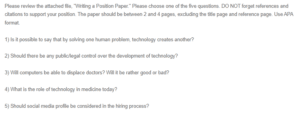Role of Technology in Medicine
Technological advancements continue to affect varied sectors, including healthcare. Its incorporation in the sector has led to diverse changes in the delivery of care. The adoption of technology in healthcare is manifested in diagnosis, management of patient information, and treatment of patients. Doctors today are able to provide diagnoses that are more accurate and secure the patient’s information better than they did in the past. Technology has had a majorly positive role in medicine due to increased efficiency and better delivery of care, improving patient outcomes. Do you need help with your assignment ? Reach out to us at eminencepapers.com.
The adoption of technology in medicine may also be blamed for issues related to insecure patient information. The storage of client data on hospital databases exposes the patient information to exposure through unauthorized means. While there are laws that govern the sharing of such information, malice can still lead individuals to use this information to harm a patient.
Role of technology in medicine
The shift from analog to digital in medicine has changed the diagnostic process significantly. Today, doctors can perform a computer tomograph (CT) scan on patients and easily identify problematic issues. Other sophisticated imaging technologies, such as the Positron Emission Tomography (PET), also enhance the process. It is now possible to view aspects of the human body that were not visible to the human eye. The use of imaging technologies has improved the productivity process as women have issues captured during the early stages of pregnancy. These adopted technological advancements have enabled doctors to be proactive and prioritize preventive care more than curative care. Doctors and fellow healthcare providers can investigate the presence of foreign organisms in the patient’s blood, stool, urine, tissue, and skin. These advanced laboratory tests enable better treatment of various conditions (Kramme & Kramme, 2011).
Doctors today are capable of accessing patient information rapidly, which facilitates the decision-making process. The adoption of technology in medicine has definitely improved the storage of information. Today, a patient’s history is recorded on an online database for easy retrieval and referral if necessary. This improvement saves the medical fraternity time and resources in the organization of physical files or the search for the same. In addition, the ease of transferring this information facilitates collaboration among doctors and other healthcare professionals (Hudson & Cohen, 2003).
Finally, telehealth has grown due to technology in medicine, making care delivery remote. Doctors and other healthcare professionals can still offer care to patients at home using teleconferencing or messages. This sort of care delivery allows patients to follow up on their appointments and medication and keep track of their health (Toh, Pawlovich, & Grzybowski, 2016). Doctors are able to follow up on patients as well, resulting in positive patient outcomes.
Conclusion
Technology has had a majorly positive role in medicine due to increased efficiency and better delivery of care, improving patient outcomes. Healthcare delivery has improved tremendously, enabling doctors to save more lives. Through the various diagnostic technology gadgets, doctors and other providers are able to offer patients the accurate diagnosis for their conditions. This is achieved through imaging scans and laboratory investigations. In addition, the ability to access patient information easily facilitates efficient care despite security concerns. Finally, the development and subsequent development of telehealth have led to better and more flexible care delivery. Patients can still consult doctors remotely, access prescriptions, and track their health successfully. The use of telehealth promotes better patient outcomes and enables the delivery of preventive care as well.
References
Hudson, D. L., & Cohen, M. E. (2003). The role of information technology in disease management. Information Technology Applications in Biomedicine, 2003. 4th International IEEE EMBS.
Kramme, R., & Kramme, H. (2011). Technology in Medicine: Its Role and Significance in Terms of Health Policy. In Springer Handbook of Medical Technology (pp. 3-6). Berlin: Springer.
Toh, N., Pawlovich, J., & Grzybowski, S. (2016). Telehealth and patient-doctor relationships in rural and remote communities. Canadian Family Physician, 62(12), 961-963.
ORDER A PLAGIARISM-FREE PAPER HERE
We’ll write everything from scratch
Question

Role of Technology in Medicine
Please review the attached file, “Writing a Position Paper.” Please choose one of the five questions. DO NOT forget references and citations to support your position. The paper should be between 2 and 4 pages, excluding the title page and reference page. Use APA format.
1) Is it possible to say that by solving one human problem, technology creates another?
2) Should there be any public/legal control over the development of technology?
3) Will computers be able to displace doctors? Will it be rather good or bad?
4) What is the role of technology in medicine today?
5) Should social media profile be considered in the hiring process?

